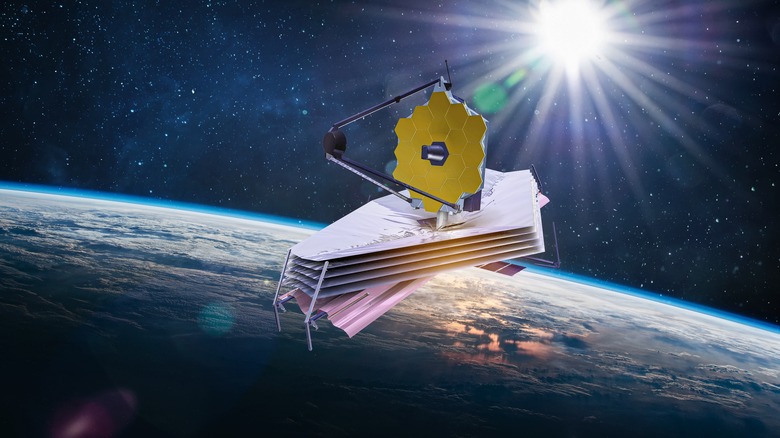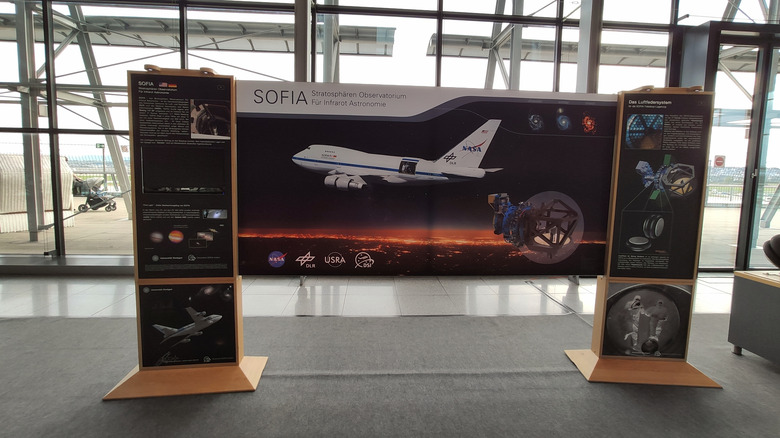Here's What We've Learned About The Milky Way's 'Galactic Bones'
The universe is filled with so many strange and exciting things. There's a certain magnetism or call to action when one gazes into the black void — which is why for centuries, human beings have tried their best to learn all of the secrets of the cosmos. But some secrets have yet to be discovered.
Earth's own galaxy, the Milky Way, is home to a number of incredible things that people are privileged to observe on a daily basis. One such jaw-dropping phenomenon can be found in what scientists call "galactic bones" — the term used for concentrations of dust and gas that make up the skeletal core of spiral galaxies like the Milky Way, per Live Science. As recently as April 2022, astronomers may have produced the most detailed galactic filament mapping yet of a Milky Way filamentary bone named G47 — and findings garnered from it may have given researchers crucial information about magnetic fields in the Milky Way (via Phys.org). Meaning? We might be able to figure out what makes the universe, well, the universe.
Why studying the Milky Way matters
The Milky Way galaxy is where the sun, the Earth, and all of our neighboring planets in the solar system reside. It is our home galaxy, so to speak. And like other galaxies in the universe, it's defined by its very composition as a very big collection of gas, dust, and stars — all kept together by the forces of gravity. Some galaxies are very big, and some are very small, but all of them have these characteristics in common (via NASA).
The Milky Way has millions of stars — more specifically, about 100 thousand million stars, per the European Space Agency (ESA) — and the center of our home galaxy is roughly 27,000 light-years away from the solar system (via Space). Studying the galaxy can give scientists a fair amount of information about how the universe came to be. For example, a glimpse at neighboring galaxies can give scientists a microcosmic view of the broader universe. And according to the Center for Astrophysics, astronomers are also getting a better idea of how galaxies evolve through the development of the Milky Way as well.
Just what are galactic bones, anyway?
So what are galactic filamentary bones, and why are they so important when it comes to the Milky Way? For those who aren't astronomers or astrophysicists, it's a lot easier to conceptualize galactic bones by comparing them to human bones. Much like how human limbs have bones at the center, the galactic arms of spiral galaxies also have filamentary bones in the center. According to Live Science, spiral galaxies are basically galaxies that have the bulk of their stars concentrated in very long arms that spiral around the center. The Milky Way is one such spiral galaxy.
These galactic bones make up the skeleton of spiral galaxies and can be very important for astronomers — especially when it comes to magnetic fields. Magnetic fields, which affect anything from how galactic bones are structured to how and why stars collapse, can be tricky to study in space — which is why these bones are crucial for understanding how galaxies operate, per Phys.org. It's also imperative for figuring out how galactic bones like G47, which is an integral part of the structure of the Milky Way galaxy, actually operate. It's also why a recent mapping of G47 — which was done as a collaboration between the German Space Agency and NASA, and with help from the airborne observatory known as the Stratospheric Observatory for Infrared Astronomy (SOFIA) — has become such a big development in the realm of astrophysics and astronomy (via Live Science).
Mapping G47 might help scientists learn more about magnetic fields
The G47 discovery is noteworthy for a few reasons. The biggest and most important one is because it's the first time magnetic fields of galactic bones have been mapped out completely, per the Universities Space Research Association. All of this was accomplished by way of SOFIA researchers, who used the SOFIA airborne observatory — a literal aircraft — to discover and record their findings.
Airborne observatories might seem strange, but they have been in use for a while now. Per NASA, airborne observatories are basically airplanes equipped with telescopes and are able to avoid observational obstacles like pollution and cloud cover (i.e., large, sky-spanning cloud masses). In other words, they enable space researchers to go where ground-based observatories might not be able to.
"Before SOFIA, it was difficult to image magnetic fields at high resolution over the entirety of the bones," said astrophysicist and researcher Ian Stephens in a statement about the importance of the aircraft technology (via NASA). "We are now able to get so many independent measurements of the magnetic field direction across these bones, allowing us to really delve into the importance of the magnetic field in these massive filamentary clouds." And according to Phys.org, it's paid off — the magnetic field survey conducted by researchers using SOFIA is among the most comprehensive as of this report.
There are more galactic bones to be mapped and studied
As stated earlier, galactic bones are a common characteristic of spiral galaxies like the Milky Way, and the methodologies used by SOFIA provide unprecedented insight into how they work. Overall, that's really good — because there are way more galactic bones out there to discover. The Milky Way's galactic bone, G47, is just one of 10 that astronomers are currently studying as of this writing.
Per Live Science, SOFIA researchers have been part of a broader effort to map entire magnetic fields of spiral galaxies through computer simulations, all in order to get a better idea of the Milky Way's cosmic skeleton. These efforts have coalesced into a larger collaborative project. Named the "Filaments Extremely Long and Dark: a Magnetic Polarization Survey," otherwise known by the acronym FIELDMAPS, the project was a long time coming, having been first introduced formally in a scientific paper published in 2015 by the Astrophysical Journal Letters.
The discovery reveals just how deep the Milky Way rabbit hole goes
Even with the strides and advances made in the field of science, the Milky Way galaxy remains enigmatic, filled with all kinds of secrets that science has yet to unearth. After all, it was only a few years ago that researchers were able to take photographs of the Milky Way's supermassive black hole for the first time in history (via PBS). In that vein, you could say there's a chance for scientists to come across a game-changing discovery every single day.
SOFIA's accomplishments are no different. According to the website for the SOFIA Science Center, new developments made by their researchers have heralded "important and unexpected discoveries about the role of the magnetic fields in nearby galaxies," ones which point toward the very composition of the cosmos itself. According to the Universities Space Research Association, developments in mapping the galactic bone known as G47 could ultimately give us exciting insights on how the universe formed these regions — and maybe one day lead us to a deeper understanding of the universe overall.





